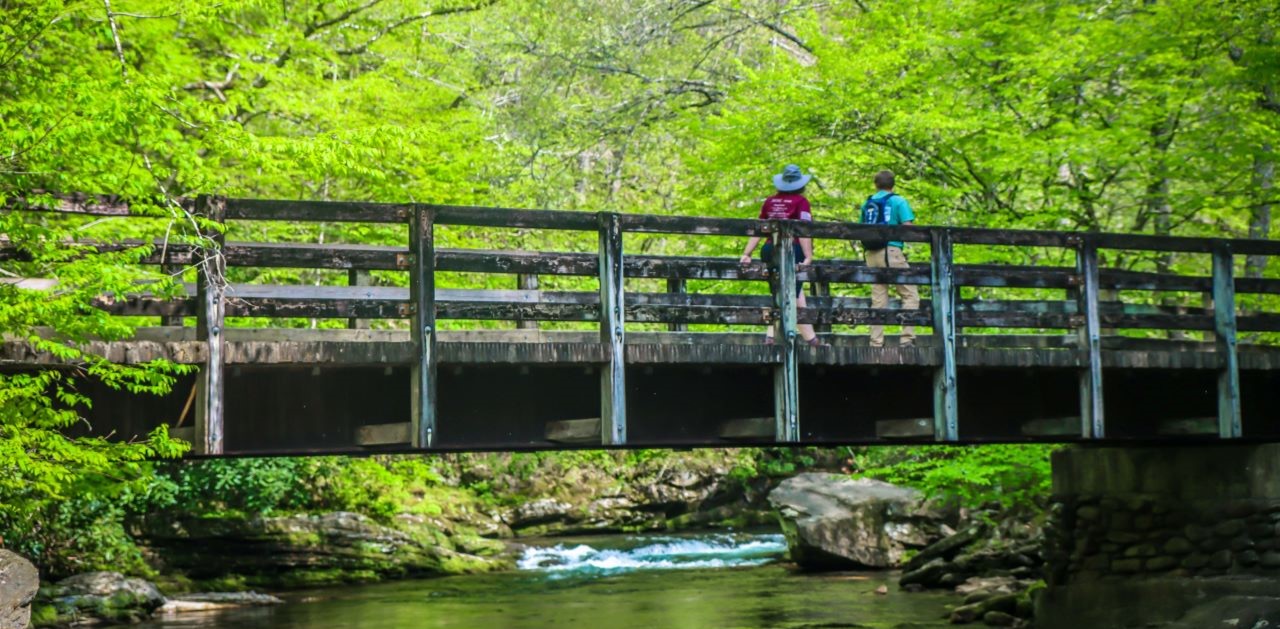

Disclaimer: This post may contain affiliate links. All hosted affiliate links follow our editorial & privacy policies.
Spanning more than half a million acres, Great Smoky Mountains National Park straddles the border of North Carolina and Tennessee .
Averaging over 14 million visitors a year, GSMNP is the most visited of all the US National Parks.
The park was commissioned by the US Congress in 1934, and officially dedicated in 1940 by President Franklin D. Roosevelt.
In 1983, it was designated a UNESCO World Heritage Site, for its biological diversity, exceptional natural beauty, and undisturbed, virgin forest . In 1988, it also become an International Biosphere Reserve.
There are many popular GSMNP spots to visit in the state of North Carolina , including Oconaluftee near Cherokee NC , Clingman’s Dome in the middle of the park, Big Creek to the far east, and Deep Creek to the far south.
Deep Creek is located right outside of Bryson City, and it’s famous for its magnificent Deep Creek waterfall hike.
Read on for our guide to visiting the Deep Creek walking trails, including descriptions of all 3 waterfalls as well as a look at other activities in this area of the Great Smokies.

Address: 1912 East Deep Creek Road
Phone: 828-488-3184 (for Deep Creek Campground)
Cost of Entry: Free
Website: NPS.gov
Amenities: Hiking/Cycling Trails, Waterfalls, Campground, Picnic Area
PDF of Trail Map: GreatSmokies.com
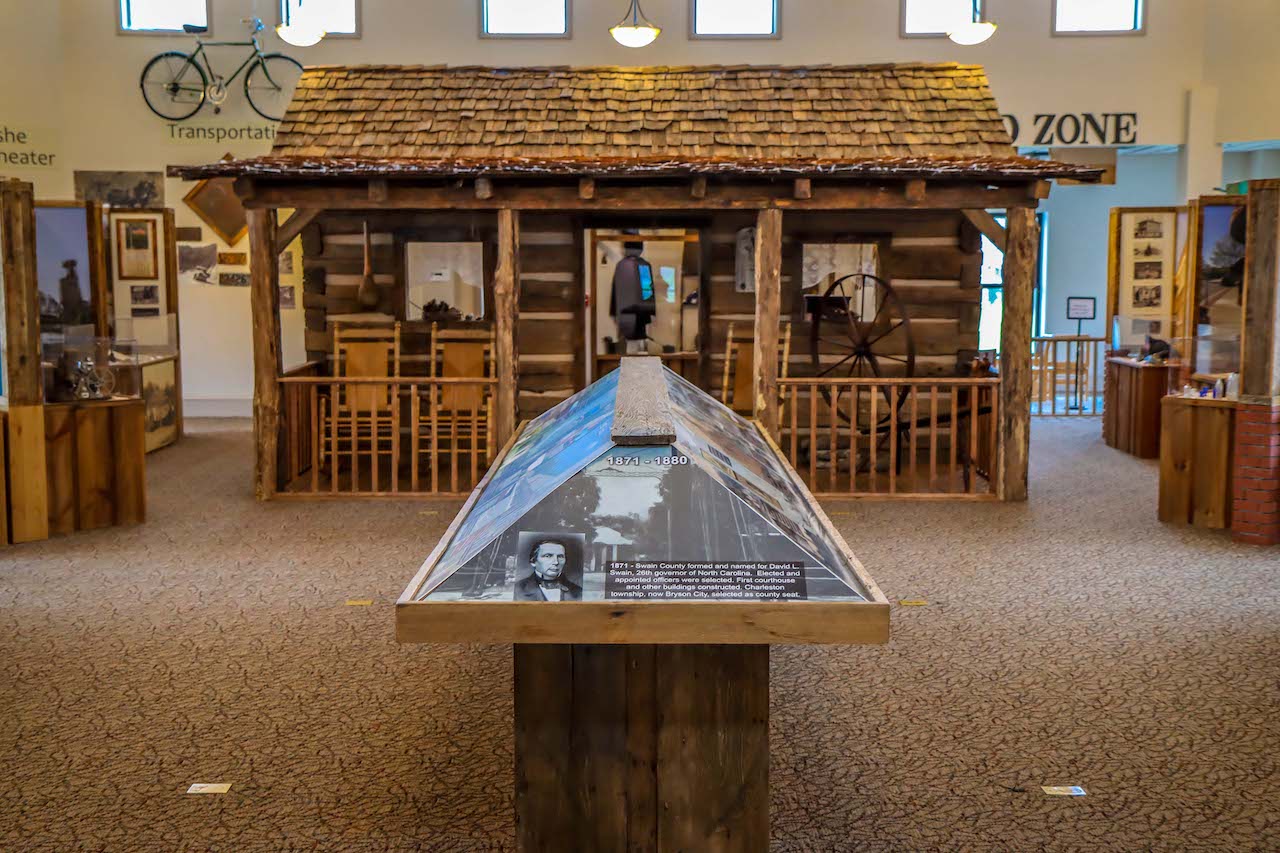
The Deep Creek area has been home to Native Americans for over 10,000 years, and it had been Cherokee territory prior to the infamous Indian Removal Act and The Trail of Tears in the 1830s.
Bryson City is located at the juncture of Deep Creek and the Tuckasegee River, with Deep Creek flowing southward from Newfound Gap in the Great Smoky Mountains.
It was sold by Cherokee chief Big Bear in 1819, then changed hands several times before becoming a little village called Bear Springs.
In 1887, the small town of Charleston NC was officially founded in the same area. A couple of years later it was renamed Bryson City, in honor of Colonel Thaddeus Dillard Bryson.
Great Smoky Mountains National Park was formed in 1933, when the US Congress gave it official park status. The effort from then on was to both preserve its beauty and make it accessible for interested visitors.
The park is brimming with history, with artifacts from prehistoric Native Americans , buildings constructed by early European settlers, and various projects of the Civilian Conservation Corps.
Deep Creek is especially recognized for its three beautiful waterfalls – Tom Branch Falls, Indian Creek Falls, and Juney Whank Falls.
It also has lovely creeks crisscrossing the landscape, with Deep Creek being the centerpiece.
The most popular Deep Creek hike is the Three Waterfall Hike.
Your shortest option is to follow the Deep Creek Loop Trail, which features three stunning waterfalls in less than three miles.
This hike is relatively easy, with a total elevation change of about 450 feet.
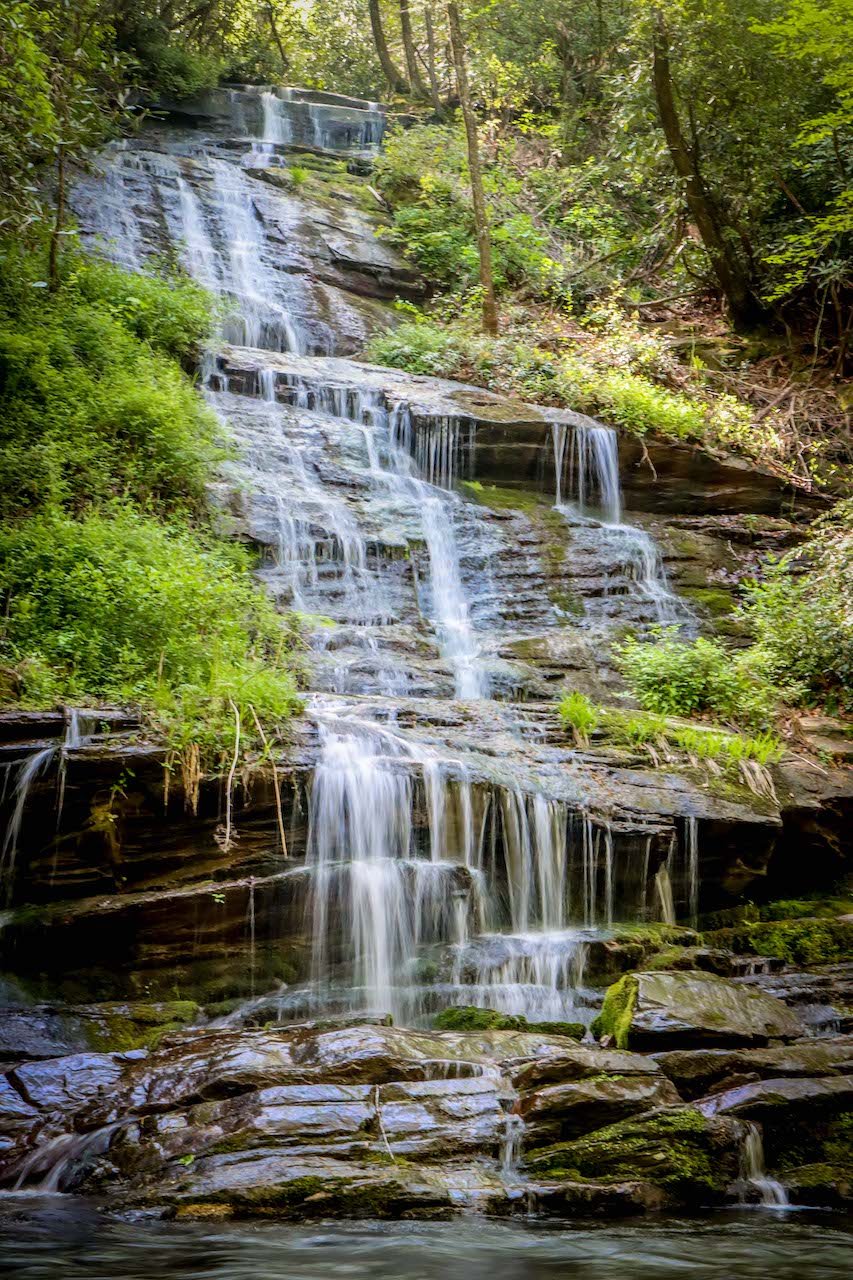
Tom Branch Falls is the easiest waterfall to reach on the Deep Creek Three Waterfall Hike.
It’s located about 1/4-mile from the parking area along a wide, fairly level trail, which is really more like a road.
Across from Tom Branch Falls, there are benches next to the creek, as well as steps leading down to it. You can often see people river tubing here, provide some entertainment as they float by.
Tom Branch Falls is a 60-foot waterfall that drops down a very steep rock face before splashing into Deep Creek. It’s a very unique arrangement for a waterfall , falling from one creek into another.
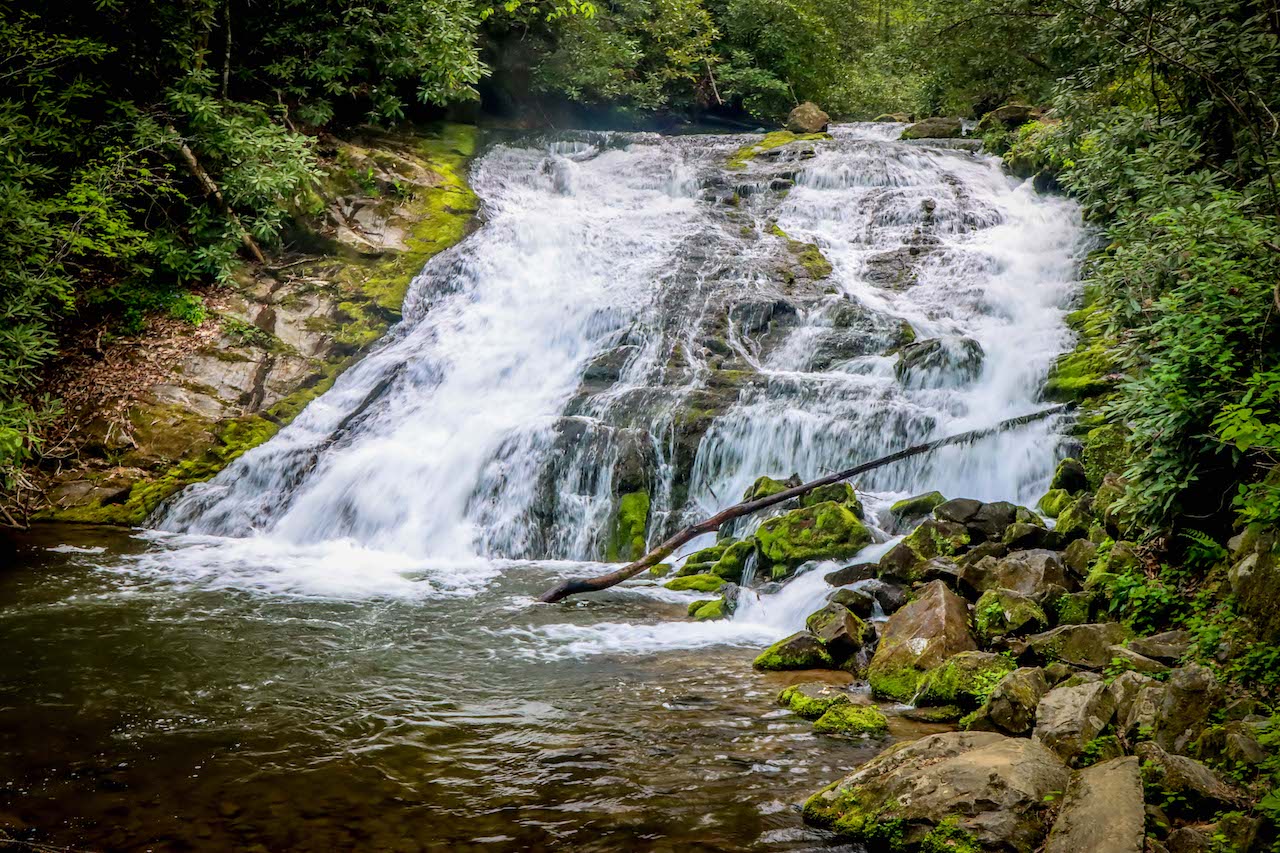
To reach Indian Creek Falls, the hike continues up the Deep Creek Trail for about a mile, where Indian Creek empties into Deep Creek.
At this point, before crossing over Indian Creek, take a right on Indian Creek Trail and you’ll see the waterfall on the left, about 200 feet uphill.
Indian Creek Falls is a wide 25-footer that makes a splashy plunge into a pool below.
We like to sit on a little island in the middle of the creek, right at the base of the falls, and have a snack or picnic.

After doubling back to the Deep Creek Trail, take a right, cross over Indian Creek and keep an eye out for the Deep Creek Horse Trail on the left.
This is the path you’ll take to get to Juney Whank Falls.
The Deep Creek Horse Trail meets the Juney Whank Falls Trail loop at just about the spot where the falls are. This loop can be taken in either direction to get back to the parking area.
Juney Whank Falls is a 90-foot waterfall with a log footbridge across it, so that the waterfall starts just above you and finishes below you.
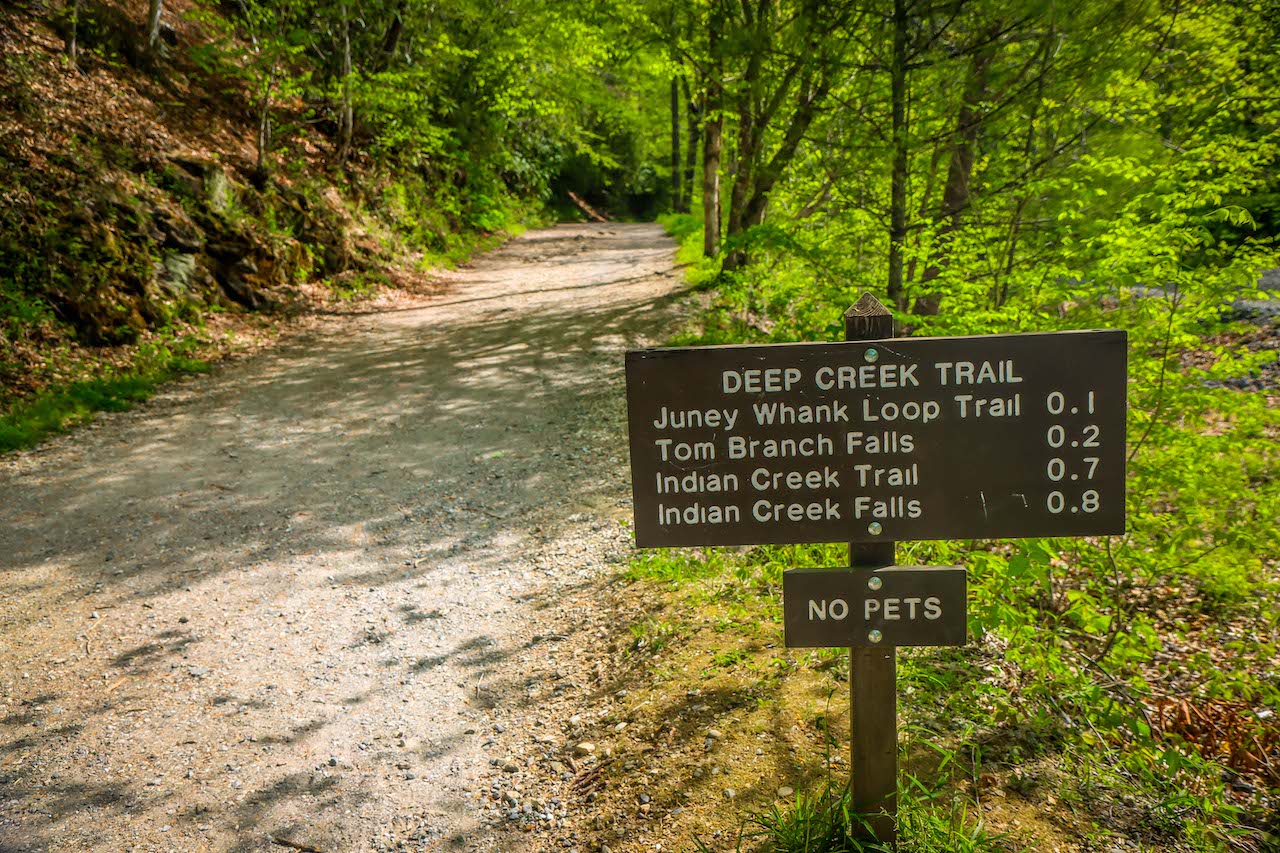
Option #2 would be to take a much longer Deep Creek Loop Trail to see the three waterfalls.
This hike loops around the other way, passing lots of colorful North Carolina wildflowers along the way.
Starting on the Juney Whank Loop, take it to the Deep Creek Horse Trail, which joins the Deep Creek Trail just beyond Indian Creek.
However, rather than returning toward Indian Creek, turn left onto the Deep Creek Trail and follow it for a mile to the Deep Creek Loop Trail (right).
This links the Deep Creek Trail to the Indian Creek Trail. Turn right onto Indian Creek and stop to see the waterfalls on the way to a new section of Deep Creek Trail.
After turning left onto the Deep Creek Trail (i.e. not crossing over Indian Creek), it leads to Tom Branch Falls and takes you all the way back to the Deep Creek Trailhead parking area.
This hike is about five miles, and involves some moderately challenging terrain.
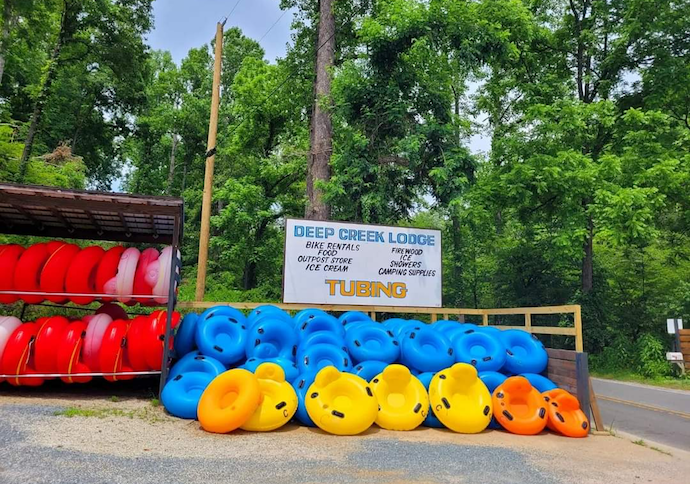
Tubing Deep Creek is one of the area’s most popular things to do in summer (from Memorial Day to Labor Day).
The roadway leading to Great Smoky Mountains National Park is riddled with rental outfits such as Deep Creek Lodge Tubing, which recently underwent a major renovation project.
Generally, tubes are rented for less than $10 for the entire day, and tubers can take the creek down and hike right back up for another float.
The upper section of the tubing route is more thrilling, with sections of moderate white water along the way.
The lower section is really placid, suitable for smaller children, and takes tubers back to their rental outlets.
Between these two sections is one of the best natural NC swimming holes in Great Smoky Mountains National Park. Note: If you don’t want to go tubing, you can still swim here for free!
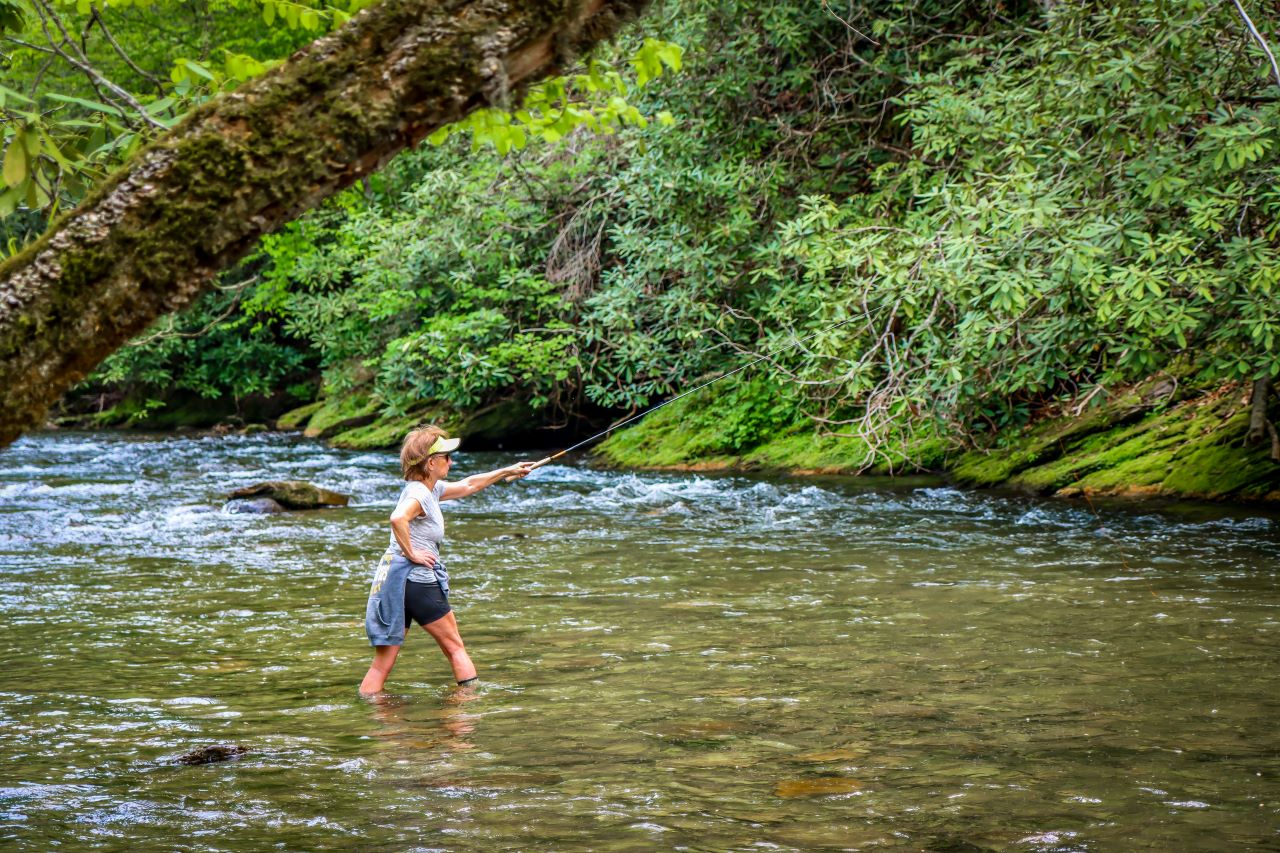
Both Deep Creek and Indian Creek are respected freestone fishing creeks.
Deep Creek is highly regarded for its native brown trout population. There are also some good rainbow trout fishing holes in the lower sections of the creek, and stained brook trout holes in the upper sections.
Fishing in Indian Creek requires going above Indian Creek Falls, a hundred yards or so from where Indian Creek dumps into Deep Creek.
Again, rainbow trout are common all through the creek, with brown trout in the lower stretches and brook trout at higher elevations.
To fish them, anglers must have either a Tennessee or North Carolina fishing license.
There are several fishing license agents in Bryson City, including Clampitt Hardware, Simond Bait & Tackle, Tuckaseegee Fly Shop, Great Smoky Mountain Bait & Tackle, and more.
 the Great Smoky Mountain Railroad in Bryson City NC" width="690" height="461" />
the Great Smoky Mountain Railroad in Bryson City NC" width="690" height="461" />
Bryson City is a full-service tourist hub with fun restaurants , souvenir shops, pedestrian areas, and regional museums .
When visiting Deep Creek, the popular North Carolina mountain town can either be your base (for those seeking fancier cabins and hotels ) or a great day trip visit.
Without a doubt, the Great Smoky Mountain Railroad is a huge draw, and it departs from Bryson City. Both diesel and steam trains are in the mix, with three different routes.
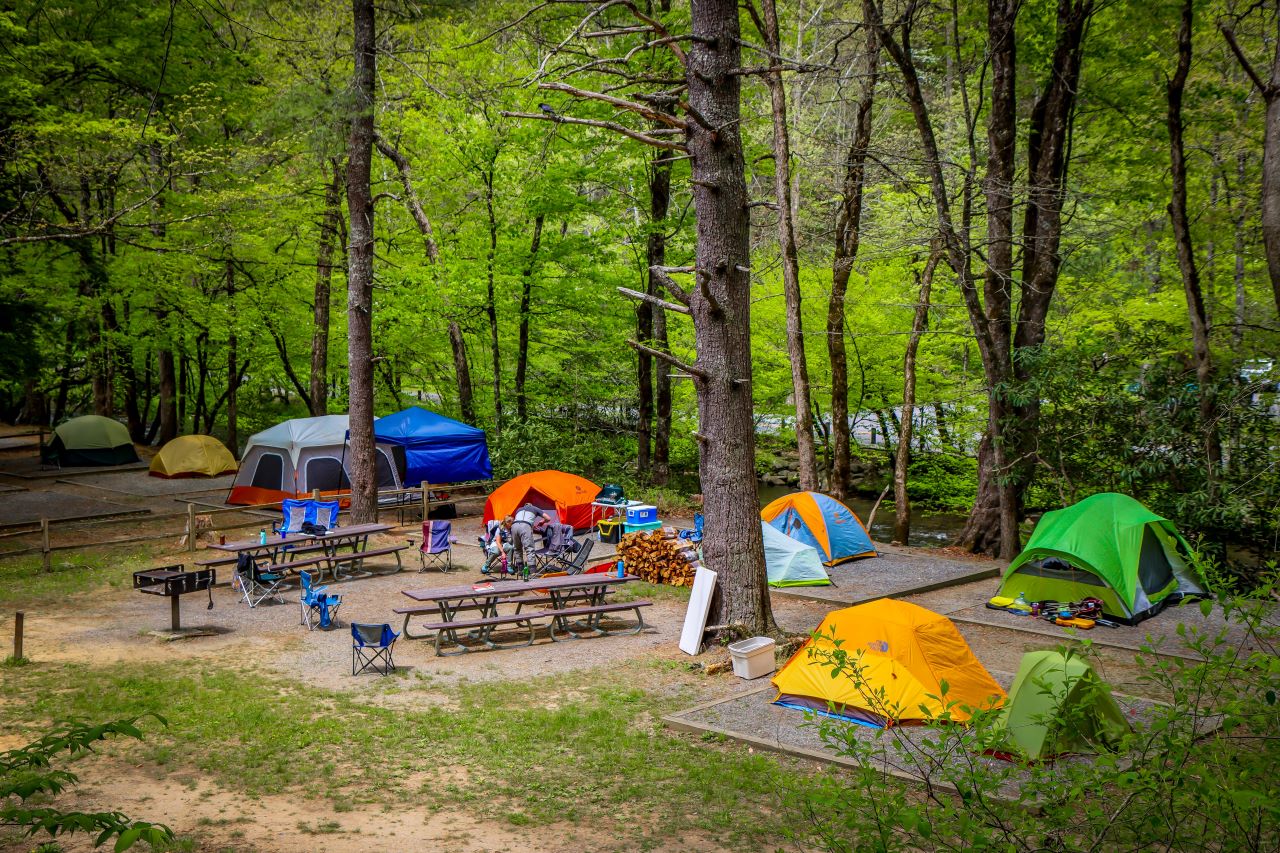
Great Smoky Mountains National Park has one of the best campgrounds in the North Carolina Mountains at Deep Creek.
Sprawling along the banks of the creek, the Deep Creek Campground features 92 campsites, with options for both tent sites and (non-electric) RV pads.
All campsites come with campfire rings, grills, and tables. The campground has flush toilets and potable water, but there are no RV hookups or hot showers available.
There are also numerous private campgrounds and cabin rentals available on the road leading into the park.
Either of these options might offer visitors who are somewhat averse to “roughing it” a touch more in terms of creature comforts. –by Jonathon Engels; all photos by Bret Love & Mary Gabbett unless otherwise noted.
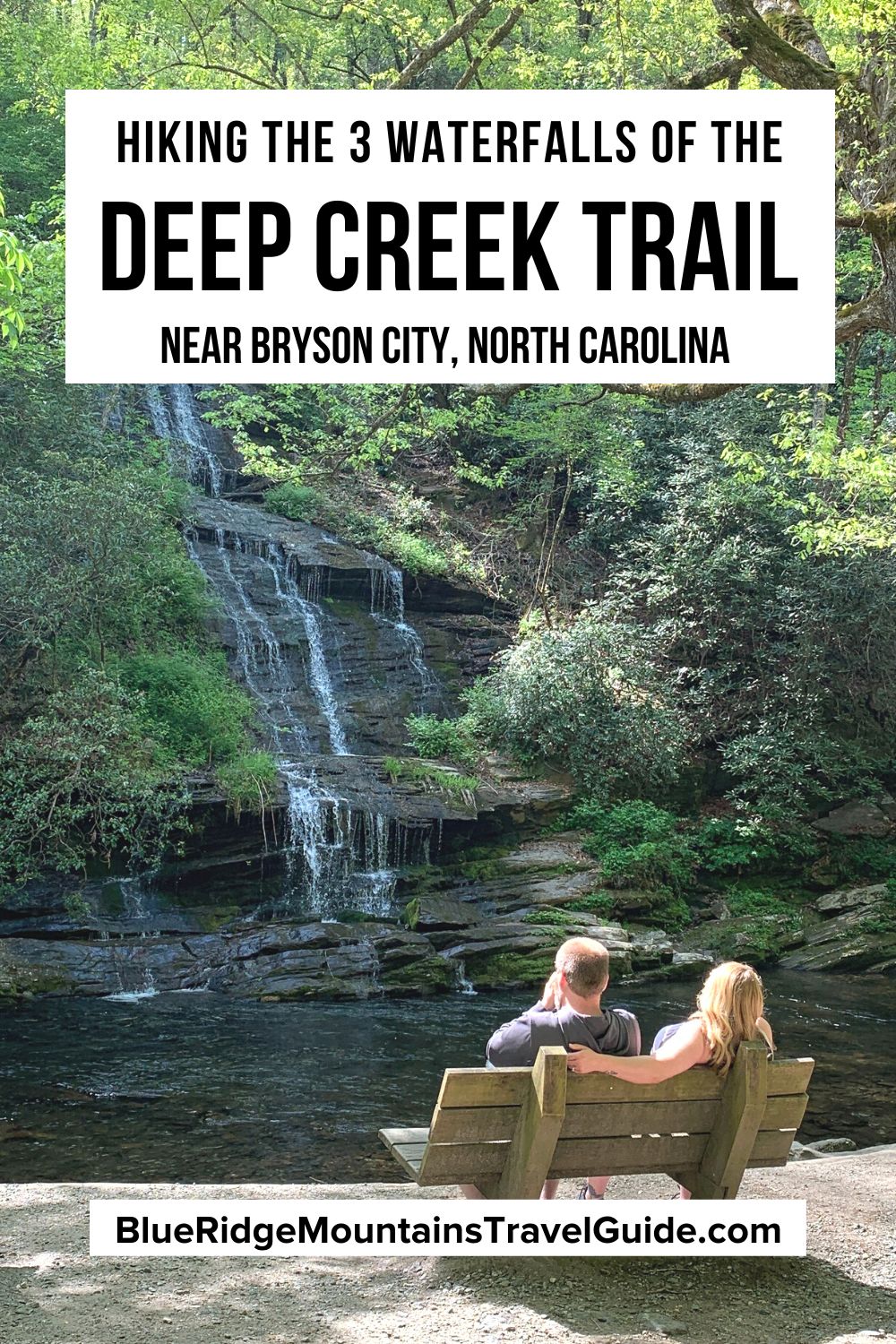
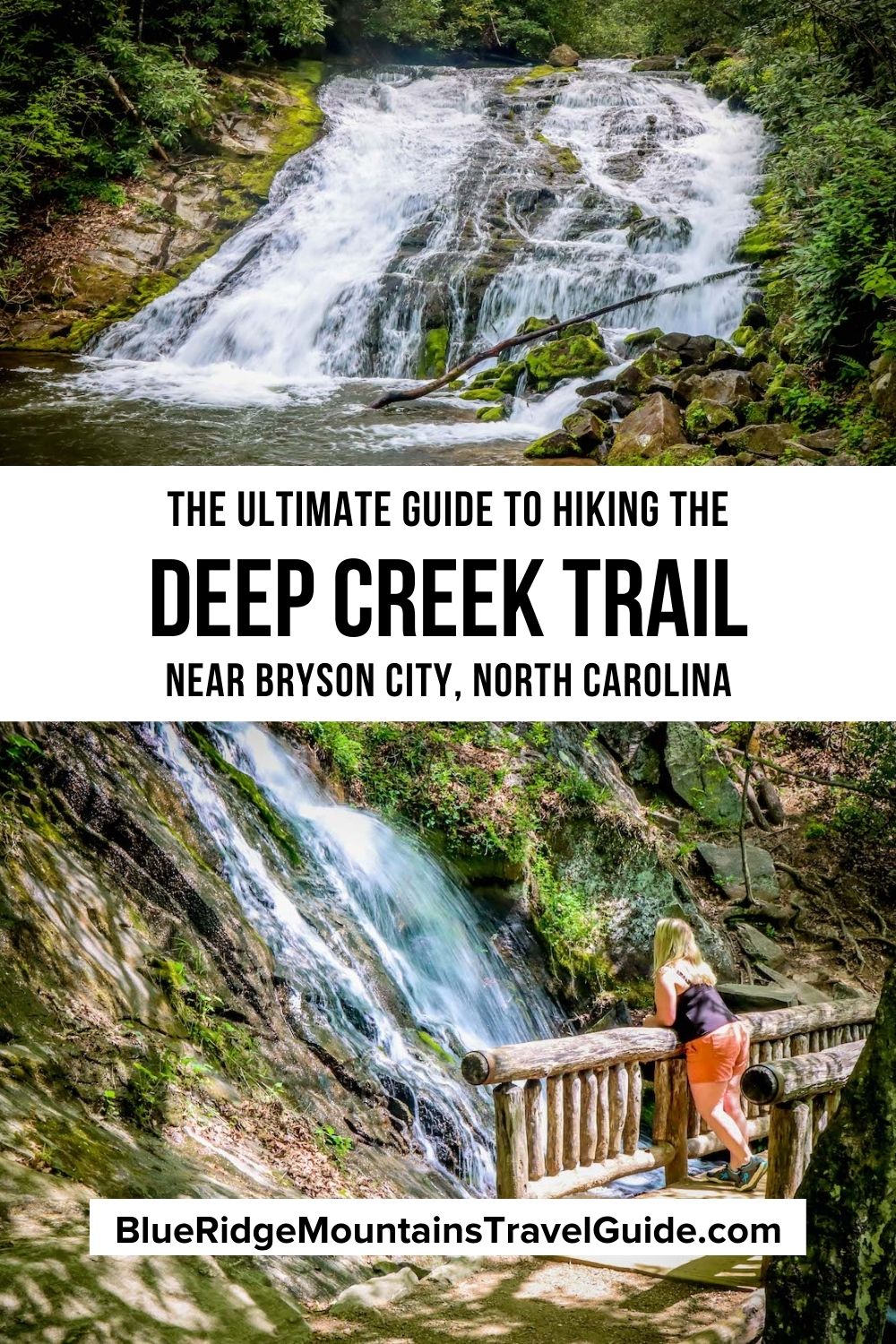

We encourage anyone who loves the Blue Ridge region to learn about the Leave No Trace principles of responsible environmental stewardship.
Stay on marked trails, take only pictures, pack out your trash, and be considerate of others who share the trails and parks you explore.
Remember that waterfalls and rocky summits can be dangerous. Never try to climb waterfalls or get close to a ledge to get a selfie.
When you're exploring the wilderness, it's better to be safe than to be a statistic!
After visiting North Carolina for the first time, Senior Writer Jonathon Engels and wife Emma spent 2 years exploring Western NC in search of a homestead property. They first lived in Brevard, where Jonathon taught writing at Blue Ridge Community College and extensively explored the Blue Ridge Parkway and Pisgah National Forest. For the last several years they have lived just off the BRP near Elkin, Southwest Virginia, and the NC High Country. The couple also volunteers with the Surry Old Time Fiddlers Convention, the Elkin Valley Trail Association, and Reeves Downtown School of Music.